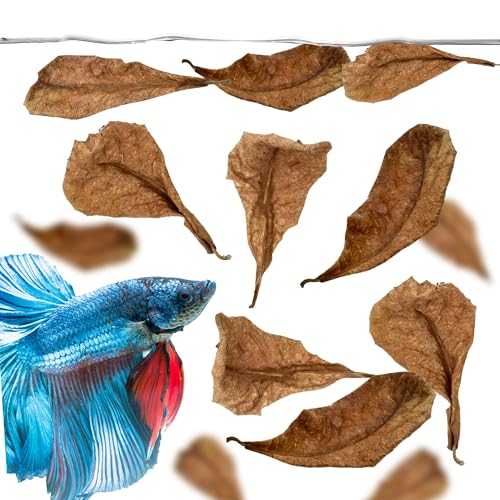Affiliate Disclaimer:
FishKeepingAnswers.com is reader-supported. When you buy through links on our site we may earn a commission.
Catappa leaves, also known as Indian almond leaves or tropical almond leaves, are a popular addition to the tanks of many aquarium and pond enthusiasts.
These leaves are native to Southeast Asia and are commonly found in tropical areas such as India, Thailand, and Malaysia.
They are often used in the aquarium and pond hobby as a natural treatment for a variety of issues, including improving water quality and promoting the health and well-being of fish and other aquatic animals.
Benefits of Catappa Leaves
One of the primary benefits of catappa leaves is that they release tannins and other beneficial compounds into the water when they decompose.
These tannins can help to lower the pH of the water, making it more acidic, which can be beneficial for certain types of fish that prefer more acidic conditions.
The tannins and other compounds released by the catappa leaves can also help to improve the overall water quality by removing toxins and other impurities from the water.
Catappa Leaves Improve Water Quality
In addition to improving water quality, catappa leaves are also believed to have medicinal properties that can help to promote the health and well-being of fish and other aquatic animals.
For example, catappa leaves are often used to treat a variety of skin and fin issues in fish, including fungus, bacteria, and parasites. They are also believed to have anti-inflammatory properties and can help to reduce stress in fish and other aquatic animals.
Catappa leaves are relatively easy to use in aquariums or ponds. They can be left whole or broken into smaller pieces and placed in the tank or pond.
As they decompose, they will release their beneficial compounds into the water. It is essential to monitor the pH of the water and make any necessary adjustments if the pH becomes too low.
Overall, catappa leaves are a useful and natural addition to the aquarium or pond that can help to improve water quality and promote the health and well-being of fish and other aquatic animals.
Where to Source Catappa Leaves
Catappa Leaves are widely available and easy to use, making them a popular choice among aquarium and pond enthusiasts.
- Give a stress-free home to your pets — You know when fish aren’t given the required environment, they come under extreme stress. Soon you will notice them hiding, white spots on their skin, scratching themselves with tank décor products, and swimming mostly on the surface. Our 60-pack miracle leaves for tropical fish by row are considered to have beneficial properties and increase fish appetite making them stress-free.
- Shield Your Beautiful Betta — More common in uncycled tanks and small bowls, fin rot begins to eat away a betta fish’s beautiful fins. Be careful not to confuse fin rot with fin biting, tearing or splitting. They are caused by physical injury from boredom, fighting or snagging sharp decor. If your betta has fin rot, you will specifically see white, red or black edges on the deteriorating fins.
- Miracle Leaves Keep Betta In An Optimal State — Fin rot, sometimes called fin melt or tail rot, is fairly common. It is caused by things that exist in your aquarium water. These undesirables start becoming a menace when your betta has a weak growth or when you are raising a vulnerable fry. You can keep your betta fish in optimal health by adding these phenomenal leaves.
- Other Medication Not Required — If you spot fin rot before it gets too severe, you can stop the spread using wholesome Indian almond leaves. Catappa leaves help your betta fish to get in better shape faster. It is best to keep catappa leaves in your tank because once fin rot becomes too bad, it will require medication.
- World Class Zoo Aquarium — Zoo aquariums do their best to recreate each resident fish’s native habitat. Why? Because it helps the inhabitants thrive. That means less stress, longer life, and better breeding. It also means you can experience your bettas, cichlids, eels, and catfish living and behaving as they would in the wild. Adding JOR Mini Catappa Leaves will help you recreate your pet’s native habitat just like zoos and aquariums do.
Last update on 2025-04-22 / Affiliate links / Images from Amazon Product Advertising API
Other Uses For Catappa Leaves
In addition to their use in the aquarium and pond hobby, catappa leaves have also been used traditionally in herbal medicine in Southeast Asia.
They are believed to have various medicinal properties, including anti-inflammatory, antimicrobial, and antioxidant effects.
One of the traditional uses of catappa leaves is as a treatment for diarrhea. The leaves are often dried and ground into a powder, which is then mixed with water and consumed as tea or taken as a capsule. Catappa leaves are also used to treat other digestive issues such as stomach aches and indigestion.
Catappa leaves are also used topically to treat a variety of skin issues. They are believed to have anti-inflammatory and antimicrobial properties that can help to soothe and heal the skin. In traditional medicine, catappa leaves are often applied as a paste to the skin or used in the form of a poultice.
There is also some evidence to suggest that catappa leaves may have a variety of other health benefits. Some studies have suggested that catappa leaves may have anti-tumor properties and may be effective in the treatment of certain types of cancer.
Other studies have found that catappa leaves may have the potential to lower cholesterol levels and improve cardiovascular health.
It is important to note that much of the research on the health benefits of catappa leaves are still in the early stages and more research is needed to fully understand their potential. As with any natural supplement, it is important to speak with a healthcare provider before adding catappa leaves to your diet or using them as a treatment for any health condition.









